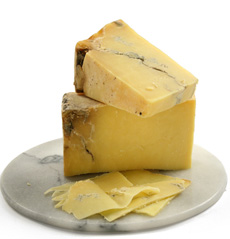
Sorry to break it to you. Cheddar isn't the magic food that will make you effortlessly skinny. But you probably already know that. It's common wisdom these days that cheese is a high-fat, high-calorie food that should be rigorously avoided, unless it's a pale cube of low-fat cheese. It's treated as if it were in the same forbidden food group as deep-fried Mars bars. Not that there's anything wrong with deep-fried Mars bars.... All around me, people (just women, in fact, from my carb-avoiding Mum to my food-loving and food-phobic girlfriends alike to my enviably skinny and toned customers at the cheese shop in N.J.) announce that are trying to eat less cheese.
Now, why would you want to do that? Yes, cheese won't make you skinny, but it won't make you fat either. You might glance at the picture above and point out my double chin to prove your point about the hazards of cheese consumption. In its defense, which I come to often, cheese alone didn't make me lose my chin (or my eyes). That was the result of living every day like it was Friday night when I was traveling for 10 months. (The eyes have to do with unfortunate genetics.) Now, to lose that weight, I'm living every day like it's Tuesday evening. But I haven't given up the cheese!
What you should be focusing on in the photo above, taken on a boat trip from the Isle of Mull in Scotland to a nearby uninhabited island where I got up close and personal with puffins, is my smile. Cheese makes you happy! As do wee puffins. It's my belief, probably unfounded by scientific, nutritional studies, that it is the satisfaction that comes from eating good cheese that prevents you from getting fat from it.
To illustrate my point, I'll share a conversation I had with one of my customers recently, a regular at the cheese counter who has a real love for cheese and who, I have to admit, has a more developed palate than I. She's probably around my age, maybe younger, and of a normal weight, and she doesn't voice any guilt about buying cheese for her and her family.
"Thanks for the cheese."
"No worries. I hope you enjoy them."
"You know, I just don't understand why we're all being told to avoid eating cheese because of the fat. I mean, look at us--you guys behind the cheese counter and me. We're not fat."
"Yeah, I know. I think that if you eat good cheese in moderation, you'll be fine."
"Well, that's it. If you eat good cheese, you're satisfied and you don't need to eat a whole lot of it. Also, I don't think that the fat in cheese is all that bad for you. See you next time."
She's onto something. Without a doubt, cheese is a nutritionally dense food, meaning that it's packed with nutrients, including fat and calories--which Americans abhor--but also protein, vitamins, and minerals--which Americans need more of (well, maybe not protein). Contrast this with nutrient-empty foods, like deep-fried Mars Bars, for which we seem to share the same level of pleasure and guilt as a schmear of a lush double-cream cheese.
So, go ahead; eat cheese! Just enjoy it, in moderation, and don't feel guilty about it. On top of that, pick something that you genuinely like. This means no virtuous, low-fat rubbery stuff. What joy is there in eating that lab concoction? This also means that you don't need to pass over the double- and triple-cream cheeses. Yes, they seem decadently rich, but ounce for ounce, they have less fat or about the same amount as sober hard cheeses. Depending on the cheese and your nutritional sources, brie has 6 grams of fat per ounce and Cheddar has 9 grams. Gasp!
How can that be? It has to do with water content. Younger cheeses, like St. Andre, have more water than the harder cheeses which lose liquid during cheese-making and aging. Think of the difference between a fresh apricot and a dried one. How many dried apricots does it take to equal the weight of a fresh one? Maybe two or three. If you eat the same amount of dried and fresh apricots in weight, you'd be getting twice or thrice the calories from the dried ones, just because you're eating more of them.
I can't help pointing this out to super-skinny customers when they moan about the amount of fat there must be in the buttery, double-cream Fromager d'Affinois, one of our best-selling cheeses. These real housewives of New Jersey are so fit and muscular that they look like world-class athletes. I refuse to fuel their masochistic guilt, and I won't be complicit in bad-mouthing cheese. On top of that, maybe these women are in need of a smile and a Friday night. Cheese can help with that!




























